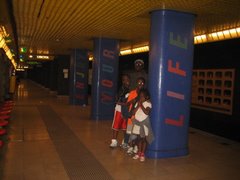
We went to Tivoli last week. Tivoli has been home to the lavish summer estates of emperors of Rome for a long time, including the villa of the Emperor Hadrian. We didn't get a chance to see Villa Adrian but we did strolled in the gardens of Villa d'Este, built by Cardinal Ippolito in the 16th century. He's apparently honored in the town for redirecting the river, saving the old cit
 y from floods.
y from floods.The gardens were magnificent! There are over 150 fountains and various kinds of statues and plants. Interestingly, there are grottos and sanctuaries for both Christian saints and traditional Roman deities. And all was built on a hill (As Clara learned, the hill was fun to descend but a pain to hike up).

I also went to the church of Santa Cecilia last week. It's one of the oldest churches in what used to be the working class area of Rome, called Trastevere. Among other pieces of art (including marble from both Egypt and Turkey), the church has a spectacular 9th century mosaic, depicting Jesus with the same kind of light that ancient Egyptians bestowed upon holy figures, an Orthodox sign of blessing, and God as a hand (an unknown). I learned that it was only in the 15th century that European Christians felt bold enough to put a face to God--they previously adhered to Jewish (and Muslim) practices of expressing God as an unknowable force.
I also learned that basilicas all have the same shape -- a rectangle with something circular at the front. The rectangle, where there are pews for people, is imperfect, like people, because it must be made from 4 different elements. Also, there was a belief that people were made from the four elements of fire, water, air, and earth. So, the people sit in the rectangle. The circular element at the top is where the mystery of God is represented. And circles, like God, are perfect. Cool, huh?













